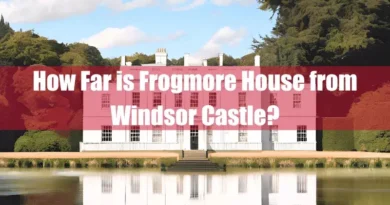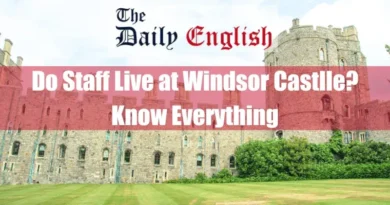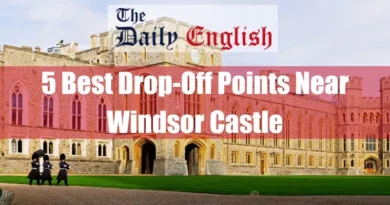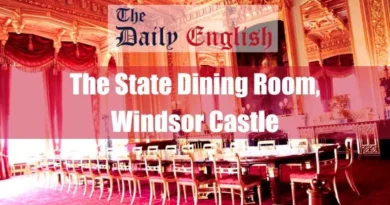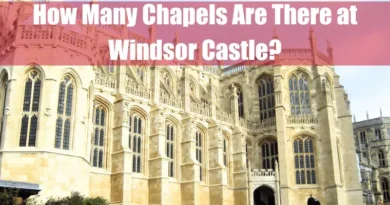Windsor Castle Top View
A top-down view of Windsor Castle reveals its distinctive layout, characterised by a central quadrangle within the Upper Ward, encircled by robust stone walls and towers. Dominating the western edge is the Round Tower, perched atop a motte. To the north, the State Apartments extend along the ward, while the east wall features a range of buildings. The private royal apartments and the King George IV Gate are situated to the south. The castle’s strategic position offers expansive views of the River Thames and the surrounding countryside.
Takeaways
| Key Points |
|---|
| An aerial view of Windsor Castle reveals its intricate layout, comprising the Middle Ward with the prominent Round Tower, the Upper Ward housing the grand State Apartments and royal private residences, and the Lower Ward featuring St George’s Chapel, a centre of royal ceremonies and the Order of the Garter. |
| The castle is enveloped by expansive landscapes, including the 265-hectare Home Park with the Frogmore estate and the Long Walk leading into Windsor Great Park, a former royal hunting ground now rich in woodlands and gardens. |
| Its proximity to the River Thames historically enhanced trade, transport, and communication, while the adjacent town of Windsor, with its historic streets, landmarks, and vibrant cultural scene, remains a key attraction. |
| Aerial imagery has captured significant royal events such as weddings and the Garter Day procession, preserving these moments in national history, with modern drone and satellite technology further aiding conservation, tourism, and historical documentation. |
| Digital advancements have also enabled virtual tours and reconstructions, offering global audiences an immersive way to explore Windsor Castle’s architecture, heritage, and landscapes. |
Introduction
Windsor Castle, located in Berkshire, England, is a royal residence with a nearly millennium history. Established in the 11th century by William the Conqueror, it has evolved from a strategic fortification into a symbol of the British monarchy. The castle’s architecture reflects various periods, showcasing medieval fortifications alongside Georgian and Victorian design elements. As the world’s oldest and largest inhabited castle, it continues to serve as a royal residence and a venue for state occasions.

Historical Background
Windsor Castle’s origins date back to the aftermath of the Norman Conquest. Initially constructed as a motte-and-bailey structure, it was strategically positioned to oversee the River Thames and protect Norman dominance around London. Over the centuries, monarchs have expanded and modified the castle, reflecting the changing needs and tastes of the times.
Construction and Architectural Evolution
The castle’s architectural journey began with wooden fortifications, which were gradually replaced by stone structures. In the 13th century, Henry III added a luxurious royal palace, enhancing the castle’s status as a royal residence. Edward III’s 14th-century renovations transformed it into a symbol of royal authority, resulting in one of the most expensive secular building projects of medieval England.
The 15th century saw the construction of St George’s Chapel, a masterpiece of Perpendicular Gothic architecture. Subsequent centuries brought Baroque and Rococo influences, particularly during the reigns of Charles II and George IV.
Role in British History
Throughout its existence, Windsor Castle has been central to British history. It has served as a royal residence, a military stronghold during conflicts such as the English Civil War, and a site for significant events, including royal weddings and state banquets. The castle was also a place of refuge; during World War II, it provided shelter to the royal family. Its continuous use underscores its enduring significance to the nation.
Architectural Layout from Above
An aerial perspective of Windsor Castle reveals a complex layout encompassing the Middle Ward, Upper Ward, and Lower Ward, each serving distinct functions.
The Round Tower and Its Prominence
Centrally located within the Middle Ward, the Round Tower stands atop an artificial motte. Originally constructed by Henry II and later heightened, it serves as a focal point, offering panoramic views of the surrounding landscape.
Upper Ward: State Apartments and Private Residences

The Upper Ward houses the State Apartments, renowned for their opulent interiors and art collections. These rooms have hosted monarchs and dignitaries, reflecting the castle’s ceremonial role. Adjacent are the private apartments, providing living quarters for the royal family.
Lower Ward: St George’s Chapel and Associated Structures
The Lower Ward features St George’s Chapel, the spiritual heart of the Order of the Garter. This Gothic chapel has been the site of numerous royal ceremonies, including weddings and funerals. Surrounding buildings accommodate the College of St George and residences for the Military Knights of Windsor, highlighting the castle’s religious and military associations.
Windsor Castle’s rich history and architectural grandeur continue to embody the legacy and traditions of the British monarchy.
Surrounding Landscapes and Features
Windsor Castle is nestled within a rich landscape tapestry that enhances its grandeur and historical significance. The castle is enveloped by the Home Park, a 265-hectare expanse that includes parkland, two working farms, and the Frogmore estate. This area provides a serene backdrop, complementing the castle’s stately presence.
The Long Walk and Windsor Great Park
Extending southward from Windsor Castle is the iconic Long Walk, a double-lined avenue of trees stretching approximately 2.65 miles. This impressive pathway leads into Windsor Great Park, a vast royal park covering about 2,020 hectares. Historically, the park served as a private hunting ground for the monarchy and now offers a diverse landscape of woodlands, grasslands, and gardens, reflecting centuries of careful stewardship.
Proximity to the River Thames

The castle’s strategic location near the River Thames has been pivotal throughout its history. The river facilitated trade, transport, and communication, contributing to Windsor’s development as a significant settlement. Today, the Thames adds to the area’s scenic beauty, offering picturesque views and recreational opportunities for visitors and residents alike.
Adjacent Town of Windsor

Adjacent to the castle lies the historic town of Windsor, renowned for its royal connections and charming character. The town boasts cobbled streets, traditional architecture, and a vibrant array of shops, restaurants, and cultural venues. Landmarks such as the Crooked House and the historic Windsor Royal Station enrich the town’s appeal, making it a focal point for tourism and local heritage.
Notable Events Captured from Above
Royal Ceremonies and Processions
Aerial views have immortalised numerous royal ceremonies at Windsor Castle, including weddings, state visits, and the Order of the Garter processions. These perspectives highlight the castle’s architectural splendour and the precision of ceremonial formations, offering unique insights into these grand events.
Historical Events and Their Aerial Documentation
Significant historical events, such as the annual Garter Day procession, have been documented from above, providing valuable records of these occasions. Aerial imagery captures the scale and context of such events, preserving moments that are integral to the nation’s heritage.
Modern Aerial Photography and Technology
Use of Drones and Satellite Imagery
The advent of drone technology and high-resolution satellite imagery has revolutionised the documentation of Windsor Castle and its environs. These tools allow for detailed surveys, conservation planning, and virtual tourism, offering new ways to experience and study the castle’s architecture and landscape.
Virtual Tours and Digital Reconstructions
Advancements in digital technology have led to the creation of virtual tours and reconstructions of Windsor Castle. These interactive experiences enable global audiences to explore the castle’s interiors and grounds remotely, enhancing accessibility and educational outreach.
Conclusion
Windsor Castle’s majestic presence is intricately linked to its surrounding landscapes and the adjacent town of Windsor. The integration of modern technology has enriched our understanding and appreciation of this historic site, ensuring that its legacy continues to captivate and educate future generations.
FAQ
What is the layout of Windsor Castle from above?
From above, Windsor Castle showcases a distinctive design comprising the Upper Ward, Middle Ward, and Lower Ward. The Round Tower stands prominently at the centre, flanked by the State Apartments, private royal apartments, and St George’s Chapel. The castle’s fortifications and gardens are also clearly visible.
How large is Windsor Castle when viewed from the top?
Covering approximately 13 acres (5 hectares), Windsor Castle’s aerial view reveals its vast expanse, including the castle buildings, gardens, and the surrounding grounds.
What notable structures are visible in a top view of Windsor Castle?
Key structures visible from above include the Round Tower, St George’s Chapel, the State Apartments, and the private apartments. The North Terrace and the Long Walk, a tree-lined avenue extending southwards, are also prominent.
How does the Round Tower appear from an aerial perspective?
Centrally located, the Round Tower is a circular stone structure that dominates the castle’s skyline. It sits atop a motte, providing strategic vantage points over the surrounding areas.
Can the Long Walk be seen in aerial images of Windsor Castle?
Yes, the Long Walk is a striking feature extending south from the castle’s gates through Windsor Great Park, lined symmetrically with trees, creating a grand approach to the castle.
What does St George’s Chapel look like from above?
St George’s Chapel appears as a large, intricately designed Gothic structure with a distinctive nave and choir. Its buttresses, stained glass windows, and the Horseshoe Cloister are clearly discernible from above.
Are the castle gardens visible in aerial photographs?
Yes, the East Terrace Garden is prominent, showcasing formal landscaping, symmetrical flowerbeds, and manicured lawns adjacent to the castle’s eastern façade.
How do the State Apartments appear from the top?
The State Apartments form a series of interconnected buildings along the north side of the Upper Ward, featuring expansive roofs and large windows overlooking the North Terrace.
Is the town of Windsor visible in aerial views of the castle?
Indeed, the town of Windsor surrounds the castle, with its historic streets, buildings, and proximity to the River Thames evident in aerial imagery.
How does the River Thames relate to Windsor Castle’s top view?
The River Thames flows north of the castle, with its meandering path and adjacent Eton College grounds visible, highlighting its strategic riverside location.
Are there any modern structures visible near Windsor Castle from above?
While the castle maintains its historic integrity, nearby modern developments, such as roads and residential areas, are visible but do not intrude upon its immediate landscape.
Can the Changing of the Guard be observed from aerial footage?
Aerial footage during the Changing of the Guard showcases formations of guardsmen in the Lower Ward, with spectators gathered along designated areas, providing a unique perspective of this ceremonial event.
How does the castle’s defensive architecture appear from the top?
The concentric layout, thick curtain walls, bastions, and arrow slits are evident from above, reflecting the castle’s medieval defensive design.
Are there any hidden features visible only from an aerial view?
Aerial views can reveal the geometric precision of the gardens, the layout of the courtyards, and the alignment of pathways not easily appreciated from the ground level.
How do seasonal changes affect the top view of Windsor Castle?
Seasonal variations influence the surrounding foliage, with lush greenery in spring and summer, vibrant hues in autumn, and a stark, bare landscape in winter, altering the castle’s visual context.
Can aerial views show the relationship between Windsor Castle and Eton College?
Yes, Eton College lies just across the River Thames to the north, with its expansive grounds and historic buildings visible in relation to the castle’s position.
How does the castle’s elevation affect its top view?
Situated on a chalk hill, the castle’s elevation provides a commanding presence over the surrounding landscape, with its terraces and slopes clearly discernible from above.
Are there any notable events captured in aerial views of Windsor Castle?
Aerial images have documented significant events, such as royal weddings and state occasions, showcasing temporary structures and crowds within the castle grounds.
How does Windsor Great Park appear concerning the castle from above?
Windsor Great Park stretches southward from the castle, with its vast woodlands, lakes, and the Long Walk creating a direct axis to the castle’s southern entrance.
Can the impact of historical expansions be seen in the castle’s aerial view?
Yes, the amalgamation of architectural styles and the castle’s sprawling footprint reflect centuries of development, visible in the varying structures and layouts within the castle complex.




